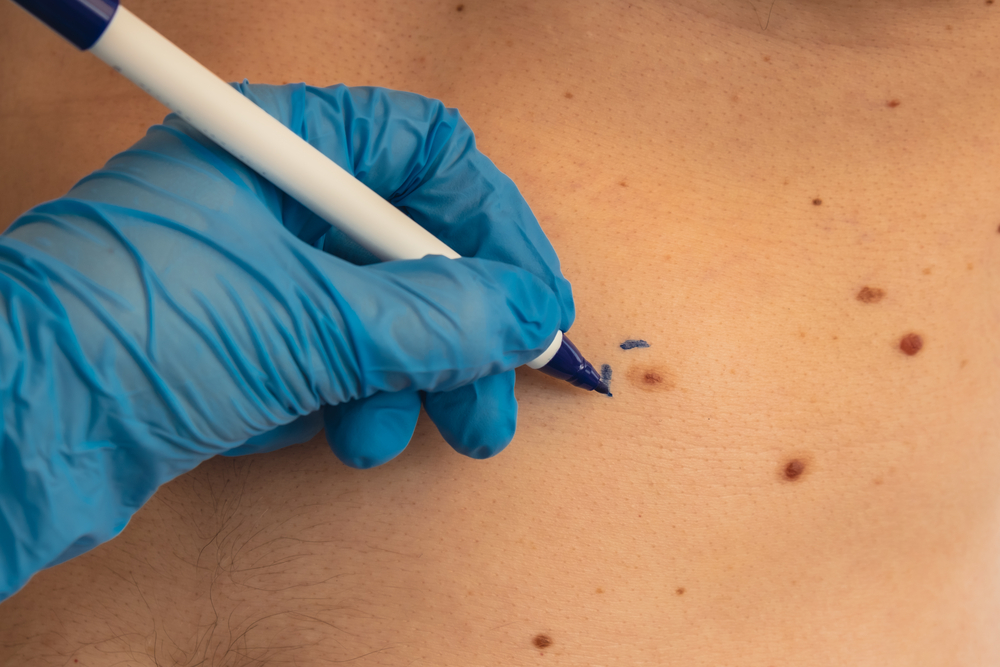Skin cancer often appears on some of the most visible parts of the body, including the face. While this can mean faster diagnosis and treatment, it also means that the scar left behind after removing the cancerous lesion may be highly visible. Fortunately, there are things that you can do, on your own and in cooperation with your surgeon, to minimize the appearance of your skin cancer removal scar.
How Does Minimally Invasive Surgery Help Reduce a Skin Cancer Removal Scar?
There are several techniques available for the excision of skin cancer. The larger the lesion, the more invasive the procedure must be, which is why regular screening and early detection are so important.
A minimally invasive skin cancer removal procedure is performed under a local anesthetic. The surgeon numbs only the lesion and the area of skin around it, and you remain conscious during the procedure.
During a skin cancer removal surgery, your surgeon takes no more healthy tissue than is necessary. After removing the tissue, the doctor sends it to a laboratory. Pathologists study the sample to check if there is a complete border of healthy tissue around the cancerous lesion. If there is not, the surgeon will contact you and ask you to come back in for another procedure to make sure no cancer remains.
Sutures
If the excision is relatively minor, your doctor will suture the wound closed. If possible, your surgeon will “hide” the scar within an existing fold of your skin, such as the crease along the edge of your nose. This helps to make the skin cancer removal scar less noticeable.
Skin Reconstruction
If the excision is deep, your surgeon may need to perform a skin flap or graft to close it. A flap is an area of skin partially detached from someplace near the wound and placed over it to close it. The flap retains its own blood supply.
A graft is a piece of skin harvested from another area of your body, usually someplace inconspicuous, such as your buttock or inner thigh. A graft does not have its own blood supply and receives it from the recipient site once the grafting procedure is complete.
How Long Does It Take for a Skin Cancer Excision To Heal?
The time it takes to recover following a skin cancer excision depends on several factors:
- The type of cancer (e.g., squamous cell carcinoma, basal cell carcinoma, or melanoma)
- The size of the lesion
- The type of procedure performed
- The type of reconstruction performed, if any
Generally speaking, you will usually have pain and redness at the surgery site for several days following the procedure. You may have to do wound care at the site for several weeks. If you have stitches, your doctor may have to remove them in several weeks. It can take a year or more for your skin cancer removal scar to “mature,” i.e., heal completely, but you should be able to return to your usual activities in a matter of days or weeks.
What Can You Do at Home To Help Reduce Skin Cancer Scars?
At first, your skin cancer removal scar may be quite red and prominent. Some people develop keloid scars that become raised and thickened. However, in most cases, scars become paler over time and less noticeable.
There are things you can do during the postoperative period to help lessen the appearance of scars.
Use Sun Protection
For the first six months to a year following your skin cancer removal surgery, you need to be extra careful to protect your scar from the sun. Whenever possible, you should cover skin cancer scars, and you should always use sunscreen on them. Exposure to ultraviolet radiation from the sun can cause scars to become discolored. A darkened scar may be even more noticeable.
Protecting your skin from the sun’s UV rays also helps prevent skin cancer recurrence.
Try Topical Silicone
Research has shown that applying silicone topically to the surgical site can help to reduce the thickness of a scar. You can start this treatment after your stitches have been removed. Silicone gel goes on clear and you can cover it with make-up. You can also use thin silicone sheets, trimming them to the desired shape as necessary.
You can continue these products for up to six months after surgery or as recommended by your doctor.
Moisturize the Wound
Keeping the wound moist helps the surgical wound to heal faster. The faster the healing, the less noticeable the skin cancer removal scar is likely to be. Your surgeon may recommend a specific ointment for you to use, such as Biocorneum, Mederma, or Strataderm. Another option may be petroleum jelly.
If you have a specific ointment you’d like to use, ask your surgeon beforehand if it is all right. Doctors typically do not recommend antibiotic ointment because you may develop an allergy to it. Your surgeon will probably instruct you on how to apply a moisturizing ointment as part of your wound care routine.
Follow Postoperative Instructions From Your Doctor
You will receive instructions on what to do after the surgery. Following the instructions helps your wound heal more quickly, minimizing the appearance of skin cancer removal scars. If you have any questions about the instructions, ask your doctor or a member of your care team.
What Medical Treatments Are Available To Improve Scar Appearance?
If you aren’t happy with the appearance of your skin cancer scars, there may be treatments available to improve their appearance. Treatment options may include:
- Steroid injections
- Microneedling
- Platelet-rich plasma injection
- Laser resurfacing
- Injectable fillers
- Dermabrasion
Ask your surgeon if one or more of these treatments would improve the appearance of your scar. Your surgeon may be able to perform these treatments or may have to refer you to a dermatologist, plastic surgeon, or other specialist.
Discuss Concerns About Skin Cancer Removal Scar With a Surgeon
Our primary objective is to remove the malignancy completely. However, we also know that minimizing the appearance of a skin cancer removal scar can be important, too. Contact us to request a consultation with one of our surgeons.
Sources:
https://www.skincancer.org/blog/embrace-your-scars/
https://skincancer.net/life-with-skin-cancer/reducing-scar-visibility
https://pubmed.ncbi.nlm.nih.gov/24085055/
https://www.skincancer.org/blog/ask-the-expert-can-i-avoid-a-scar/
https://medlineplus.gov/ency/patientinstructions/000743.htm
https://myhealth.alberta.ca/Health/aftercareinformation/pages/conditions.aspx?hwid=abp7912
https://www.plasticsurgery.org/reconstructive-procedures/skin-cancer-removal/recovery
https://nyulangone.org/conditions/basal-squamous-cell-skin-cancers/treatments/surgical-procedures-for-basal-squamous-cell-skin-cancers
https://www.cancerresearchuk.org/about-cancer/skin-cancer/treatment/surgery/surgery-for-larger-skin-cancers/after-surgery




